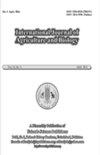Host Dependent and Geographical Structuring of Citrus Canker Bacteria at Peshawar, Pakistan
Q2 Agricultural and Biological Sciences
引用次数: 0
Abstract
Citrus canker disease, caused by Xanthomonas axonopodis pv. Citri (Xac) induces huge losses to citrus, particularly in nurseries. This study assessed the level of genetic diversity and divergence in Xac population prevalent in district Peshawar on various host species, based on isolates collected from different fruit nurseries of Peshawar. Surveillance resulted in collection of 80 samples, out of which 50 bacterial samples were isolated. Genotyping of the isolates using RAPD markers amplified 35 scorable loci with an average of 8.7 loci per primers and level of polymorphism was 100%, i.e., almost all of the isolates genotyped had a different multilocus genotype. The loci GLA-031000 was recorded with the highest gene diversity (0.51) followed by GLB-05_1000 and GLA-03_1100 (0.49). The maximum diversity index (0.50) was recorded for loci GLA-031000, followed by GLB-051000 and GLA-03_1100 (0.48). A high diversity was observed across all locations, with the range of genotypic diversity from 0.778 (detected at Malakandair) to 0.955 (detected at Hayatabad and Tarnab). Divergence between samples collected from different locations was limited as revealed by the PCA, PCoA, phylogenetic tree and network analyses. Samples originated from various hosts also revealed a high diversity across host types with the minimum genotype diversity observed for Eureka Lemon (0.750) and the maximum for sweet lemon (0.966). The divergence for samples collected on various citrus host types was absent. The very small linkage disequilibrium (0.006–0.159) reflected on the potential recombination in the population, which must have direct implications to disease management and resistance exploitation. © 2021 Friends Science Publishers巴基斯坦白沙瓦柑桔溃疡病菌的寄主依赖性和地理结构
柑橘溃疡病,由轴索黄单胞菌引起。柑桔(Xac)对柑桔造成巨大损失,尤其是苗圃。本研究以白沙瓦市不同果树苗圃为研究对象,对白沙瓦市白沙瓦市不同寄主种群的遗传多样性和遗传分化水平进行了评价。监测结果收集了80个样本,其中分离出50个细菌样本。利用RAPD标记对分离物进行基因分型,扩增出35个可评分位点,平均每个引物扩增8.7个位点,多态性水平为100%,即几乎所有分离物都具有不同的多位点基因型。基因多样性最高的是GLB-05_1000位点(0.51),其次是GLB-05_1000和GLA-03_1100位点(0.49)。GLA-031000位点多样性指数最高,为0.50,其次为GLB-051000位点和GLA-03_1100位点,多样性指数为0.48。基因型多样性从0.778 (Malakandair)到0.955 (Hayatabad和Tarnab)不等。PCA、PCoA、系统发育树和网络分析显示,不同地点的样本差异有限。不同寄主的基因型多样性也很高,尤里卡柠檬的基因型多样性最低(0.750),甜柠檬的基因型多样性最高(0.966)。在不同寄主类型上采集的样品没有差异。非常小的连锁不平衡(0.006-0.159)反映了群体中潜在的重组,这必然对疾病管理和抗性开发具有直接意义。©2021朋友科学出版社
本文章由计算机程序翻译,如有差异,请以英文原文为准。
求助全文
约1分钟内获得全文
求助全文
来源期刊

International Journal of Agriculture and Biology
AGRICULTURE, MULTIDISCIPLINARY-
CiteScore
1.70
自引率
0.00%
发文量
40
审稿时长
5 months
期刊介绍:
Information not localized
 求助内容:
求助内容: 应助结果提醒方式:
应助结果提醒方式:


